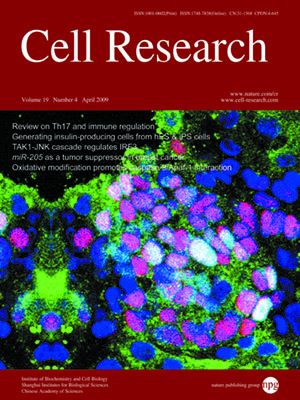
Volume 19, No 4, Apr 2009
ISSN: 1001-0602
EISSN: 1748-7838 2018
impact factor 17.848*
(Clarivate Analytics, 2019)
Volume 19 Issue 4, April 2009: 497-506
ORIGINAL ARTICLES
The differential protein and lipid compositions of noncaveolar lipid microdomains and caveolae
Yao Yao1, Shangyu Hong1, Hu Zhou2, Taichang Yuan1, Rong Zeng2 and Kan Liao1
1State Key Laboratory of Molecular Biology, Institute of Biochemistry and Cell Biology, Shanghai Institutes for Biological Sciences, Chinese Academy of Sciences, Shanghai 200031, China
2Research Center for Proteome Analysis, Institute of Biochemistry and Cell Biology, Shanghai Institutes for Biological Sciences, Chinese Academy of Sciences, Shanghai 200031, China
Correspondence: Kan Liao,(kliao@sibs.ac.cn )
Morphologically, caveolae and lipid rafts are two different membrane structures. They are often reported to share similar lipid and protein compositions, and are considered to be two subtypes of membrane lipid microdomains. By modifying sucrose density gradient flotation centrifugation, which is used to isolate lipid microdomains, we were able to separate caveolae and noncaveolar lipid microdomains into two distinct fractions. The caveolar membranes are membrane vesicles of 100-nm diameter, enriched with caveolin-1 and flotillin-1. The noncaveolar lipid microdomains are amorphous membranes and most likely the coalescence of heterogeneous lipid rafts. They are depleted of caveolin-1 and are more enriched with cholesterol and sphingolipids than the caveolae. Many membrane proteins, such as insulin-like growth factor-1 receptor (membrane receptor), aquaporin-1 (membrane transporter), Thy-1 and N-cadherin (glycosylphosphatidylinositol-anchored membrane protein and membrane glycoprotein), are specifically associated with noncaveolar lipid microdomains, but not with caveolae. These results indicate that the lipid and protein compositions of caveolae differ from those of noncaveolar lipid microdomains. The difference in their protein compositions implies that these two membrane microdomains may have different cellular functions.
Cell Research (2009) 19:497-506. doi: 10.1038/cr.2009.27; published online 3 March 2009
FULL TEXT | PDF
Browse 1915


